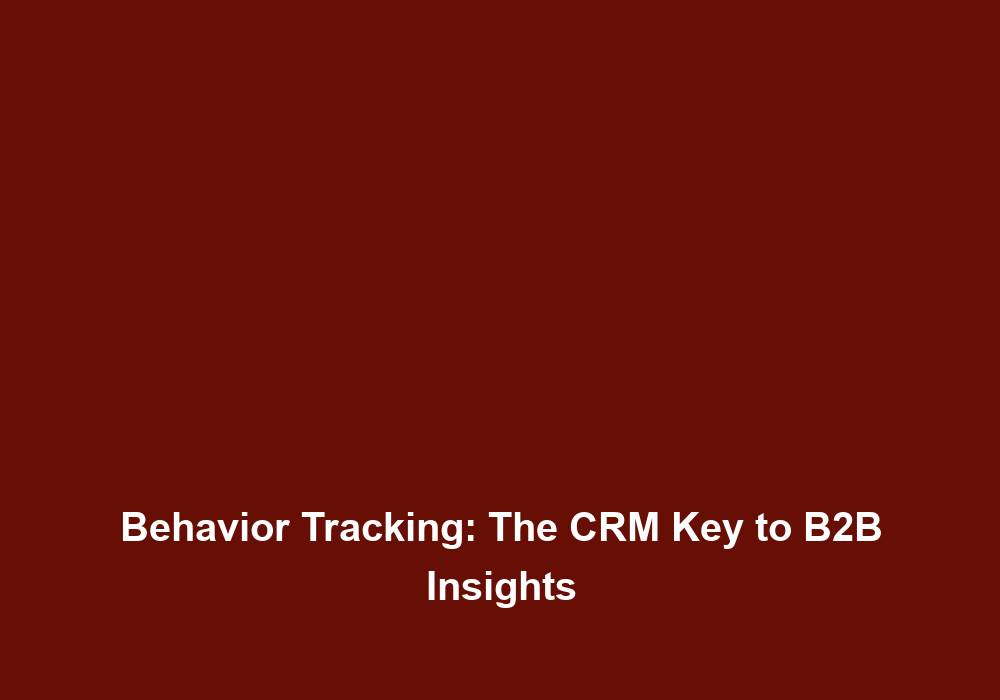In today’s highly competitive business landscape, companies are constantly seeking ways to gain a competitive edge and maximize their marketing efforts. One effective strategy that has gained significant popularity in recent years is data-driven segmentation in B2B marketing, specifically through the use of Customer Relationship Management (CRM) systems. This article will delve into the concept of data-driven segmentation in B2B marketing and explore how businesses can leverage CRM to enhance their segmentation strategies.
Understanding Data-Driven Segmentation
Data-driven segmentation is the process of dividing a target market into distinct groups based on specific characteristics and behaviors. This segmentation approach allows businesses to tailor their marketing efforts and deliver personalized messages to each segment, thereby increasing the effectiveness of their campaigns.
In B2B marketing, data-driven segmentation goes beyond basic demographic information such as industry, company size, or geographic location. It involves analyzing vast amounts of customer data to identify patterns, preferences, purchase history, and other relevant factors. By leveraging CRM systems, businesses can effectively collect, store, and analyze this valuable customer information.
Leveraging CRM for Data-Driven Segmentation
A CRM system acts as a centralized database that stores and organizes customer data, interactions, and transactions. By utilizing CRM tools, businesses can gain valuable insights into their customers and prospects, enabling them to create more targeted and personalized marketing campaigns.
1. Collecting Relevant Data
To effectively implement data-driven segmentation, businesses must ensure that their CRM system captures and stores the necessary data. This may include information such as:
- Contact details: Name, email address, phone number, job title, etc.
- Company information: Industry, company size, location, etc.
- Engagement data: Interactions with the company’s website, downloads, email opens, etc.
- Purchase history: Previous purchases, average order value, frequency of purchases, etc.
By collecting and organizing this data in a CRM system, businesses can have a comprehensive view of their customers and prospects, which forms the foundation for effective segmentation.
2. Analyzing Customer Data
Once the relevant data is collected, businesses can leverage CRM analytics tools to gain insights into their customer base. CRM analytics allows businesses to identify patterns, trends, and correlations in the data, enabling them to segment their customers effectively.
When analyzing customer data for segmentation purposes, it is important to consider key factors such as:
- Buying behavior: Identifying the most profitable customers, frequent purchasers, or customers who have lapsed. This information helps businesses focus their marketing efforts on the most valuable segments and tailor their messaging accordingly.
- Preferences: Understanding customer preferences, interests, and pain points is crucial for delivering personalized messaging. By identifying common preferences within segments, businesses can create targeted campaigns that resonate with their audience.
- Customer lifecycle stage: Segmenting customers based on their position in the sales funnel, such as leads, prospects, or repeat buyers. This allows businesses to deliver the right content at the right time, nurturing leads and maximizing conversion rates.
- Geographic or demographic factors: Segmenting customers based on location, industry, company size, or any other relevant criteria. This helps businesses target specific markets or industries with tailored marketing strategies.
By analyzing these factors, businesses can create meaningful segments that allow for targeted marketing efforts.
3. Creating Customer Segments
Once the analysis is complete, businesses can begin creating distinct customer segments based on their findings. Each segment should have unique characteristics and behaviors that enable tailored marketing strategies.
In B2B marketing, some common customer segments may include:
- Decision-makers: Individuals within organizations who have the authority to make purchasing decisions. These individuals are crucial to target as they hold the power to influence the buying process.
- Influencers: Individuals who may not have the final say but can influence the buying decision. Understanding the influencers within a target market helps businesses craft messages that resonate with this group.
- Early adopters: Companies that are more likely to embrace new technologies or solutions. These segments are essential for businesses introducing innovative products or services.
- Lapsed customers: Previous customers who have not made a purchase in a specific timeframe. Re-engaging with lapsed customers can be a cost-effective strategy for businesses.
It is important to note that the number and types of segments will vary depending on the nature of the business and its target market. A thorough analysis of customer data is essential to identify the most relevant segments for a particular business.
4. Personalized Marketing Campaigns
With well-defined customer segments in place, businesses can now create personalized marketing campaigns tailored to each segment’s needs, preferences, and pain points. This level of personalization allows businesses to enhance customer engagement, improve conversion rates, and ultimately drive revenue growth.
To deliver personalized marketing campaigns, businesses can consider the following strategies:
- Customized messaging: Crafting targeted messages that resonate with each segment, addressing their specific pain points and offering tailored solutions. This approach ensures that the message is relevant to the recipient, increasing the likelihood of capturing their attention.
- Personalized content: Creating content that aligns with each segment’s interests, challenges, and goals, positioning the business as a trusted advisor. This content can take the form of blog posts, whitepapers, case studies, or industry reports.
- Channel optimization: Identifying the most effective channels for reaching each segment and allocating marketing resources accordingly. Some segments may respond better to email marketing, while others may prefer social media or direct mail. By optimizing the channels, businesses can maximize the impact of their marketing campaigns.
By leveraging CRM data and implementing data-driven segmentation, businesses can significantly improve their marketing efforts and drive better results.
Conclusion
In conclusion, data-driven segmentation is an essential strategy for B2B businesses looking to optimize their marketing efforts. By leveraging CRM systems and analyzing customer data, businesses can create meaningful segments and deliver personalized marketing campaigns. This approach allows businesses to better understand their customers, enhance engagement, and ultimately drive revenue growth. Adopting a data-driven segmentation approach in B2B marketing can give businesses a competitive edge in today’s dynamic business landscape.
